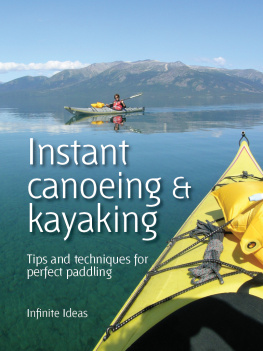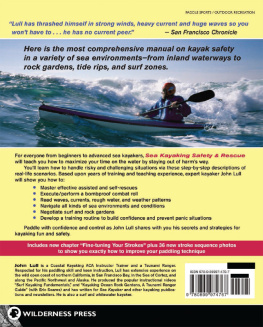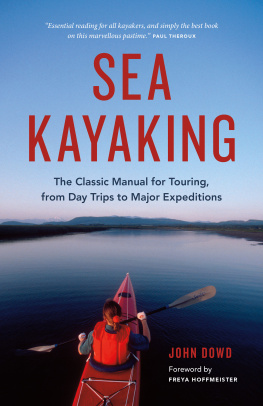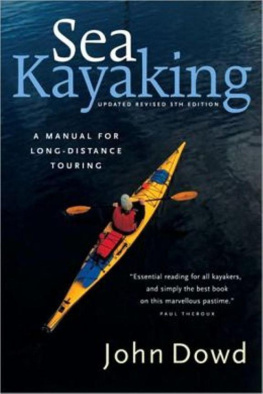About the Author
Dennis Stuhaug lives much of the year on a drying bay in Washington State, dividing his time between writing, paddling, and researching his next trip in the wake of early European explorers along North Americas northwest coast. Its a twenty-minute paddle to the village, a two-hour bicycle ride to the city, and a month and a halfs paddle to Alaska. Deer and otter are on the beaches; seals, sea lions, and a variety of whales patrol the deeper waters, but surface to watch a passing kayak. Hes working on another book, and working with state and national agencies on a variety of boating and water safety issues.
Acknowledgments
No one ever paddles alone. We are accompanied by generations of silent, invisible companions; we share the water and the knowledge we have gleaned from everyone whose wake we cross. I have been particularly blessed with the privilege of paddling with three extraordinary kayak designers and builders: Lee Moyer, who by example set a standard for stewardship of our waters; Peter Kaupat, who insisted that perfection is attainable; and Werner Furrer Sr., who constantly reminded me that the ultimate reason for paddling is enjoyment. I deeply appreciate the hard work, dedication, and professionalism of the editors at FalconGuides. They make editing a high art and in doing so, unscrambled my syntax. And I take full credit for any remaining mistakes or confusions.
CHAPTER 1 You Can Learn to Kayak
Sprawl back on the beach with me, enjoying the warmth of the afternoon sun. Wiggle about a bit on the fine gravel to form a little depression to sit in, and dig a pair of heel holes more for the fun of it than for any support. A sea kayak with a red deck is carving a long vee through the riffles on the dark water, silently and swiftly. It doesnt look at all hard, judging from the ear-to-ear grin on the lone paddlers face. The smooth pattern of her strokes looks like something you could do.
You shake your head. Anything that looks that easy must be really hard to do, or it must take a long timea really long timeto learn. She was probably born with a paddle in her hands, and her folks were paying big money for sports lessons when she was just a toddler.
Sorry to break into your dreams on such a nice day with a cold dose of reality, but at best you are way less than half right. The smile plastered all over that paddlers face is absolutely real, and the grace she exhibits as she almost effortlessly rounds the point off to your left is totally genuine. Paddling a kayak is totally fun. But being so difficult that mere mortals could never learn to do it? Wrong in a big way. This is an activity for todays world: low impact on you, and a light touch on the world through which you pass. Low cost, low technology, and a low learning curve for the person who wants to explore all the delightful vagaries along the break where the water meets the shore.

Im willing to bet you that candy bar in your pocket that you can learn to get into a boat just like that one and paddle it in ten minutes or so. Lets keep a handle on reality here. In ten minutes youre not going to show off the grace and elegance of the lady who just glided past. You probably wont even paddle in an approximately straight line. You will splash and you will puff. But you will be paddling; you will be in command of your own ship.
Okay, I hedged that wager a bit. I know that you are in good health and physically fit enough for moderate exercise. If we had a question about that I would have suggested having a chat with your doctor, as most of us should before beginning any new exercise. Dont hear this as a warning that paddling is only for the physically elite. Almost any challenge we may face can be accommodated within the cockpit of a kayak. Theres a place for all of us, whether it be camping, cruising, or competing.
I also know that you can swimalthough you dont have to know how to swim before boarding a kayak. I know paddlers who cant swim a stroke. However, I also know that folks who cant swim often (and often unconsciously) fear the water. They stiffen up at every pitch or roll of a kayak, and it is more difficult to either lean a kayak or trust their balance to the power of their paddle. Swimmers tend to be more confident and relaxed, allowing them to enjoy the learning experience more easily. Non-swimmers tend to be more hesitant. This is not a bad thing; wed just have to play a bit more on building confidence and comfort.

If you and I spent an entire morning on the beach, you would be able to climb into your boat, push off from shore, and head in a reasonably straight line to a destination of your choice. In a day or so, youd have all the skills you need to be a welcome addition to just about any group of paddlers. I dont mean a master mariner, with kelp in your hair and a compass clutched in your teeth. That would be lying, and to grasp the essential simplicity of a sea kayak we have to build a bond of trust. Want to try?
First of all, lets change the name of this vessel. Well call it a cruising kayak. Thats only a small difference, but it opens up a whole world of lakes, big rivers, and small ponds as well as salt water. Our cruising kayak, sometimes called a touring kayak or a sea kayak, is designed for an environment where the primary forces are wind and often tide. Wind is the power that generates waves. A whitewater kayak is designed to slide downhill and cope with currents in the moving water. That said, Ive been blown all over a river by winds and have played in boisterous currents in the sea.
Its my experience that the cruising kayaker has an entirely different mind-set from that of the whitewater boater. The whitewater boater sits in a tool that is part of the sport. The cruising kayaker, on the other hand, shares a partnership with a subtle and responsive craft in the exploration of an activity. Sure, some people race these long and skinny boats. Others voyage for great distances with all their possessions stored belowdecks. Some plop their boats in the water for an afternoons outing and a picnic. Still others churn the water over a limited course in search of exercise. Whatever works. But I notice that a fairly high percentage of cruising kayakers name their boats, while most whitewater boaters plan on replacing theirs every few years.
Theres also a difference in execution, even though many of the strokes and skills can be readily transported from one kind of kayak to the other. About three-quarters of a whitewater boaters moves are reactionary, while three-quarters of a cruising kayakers actions are based on contemplation and preparation.
Neither is more challenging, nor requires a higher level of skill or ability. Neither is a stepping-stone to the other. They are simply two separate ways of having fun on the water with a paddle in your hand.
A Mini-History
Back in the nineteenth century, cruising kayaks were a rarity. Sure, there were guides with canoes who would take curious travelers into the woods, but the wilderness was mainly the haunt of outfitters, swells, and a handful of folks who made their living in the small byways of the water world. Then, in the 1880s, George Sears glided into the American consciousness with his stories of exploring the Adirondacks alone with a lightweight canoe and minimal camping gear. Sears became one of the most popular American outdoor writers, convincing his readers that anyone could follow comfortably in his wake without the expense and formality of a professional guide.










